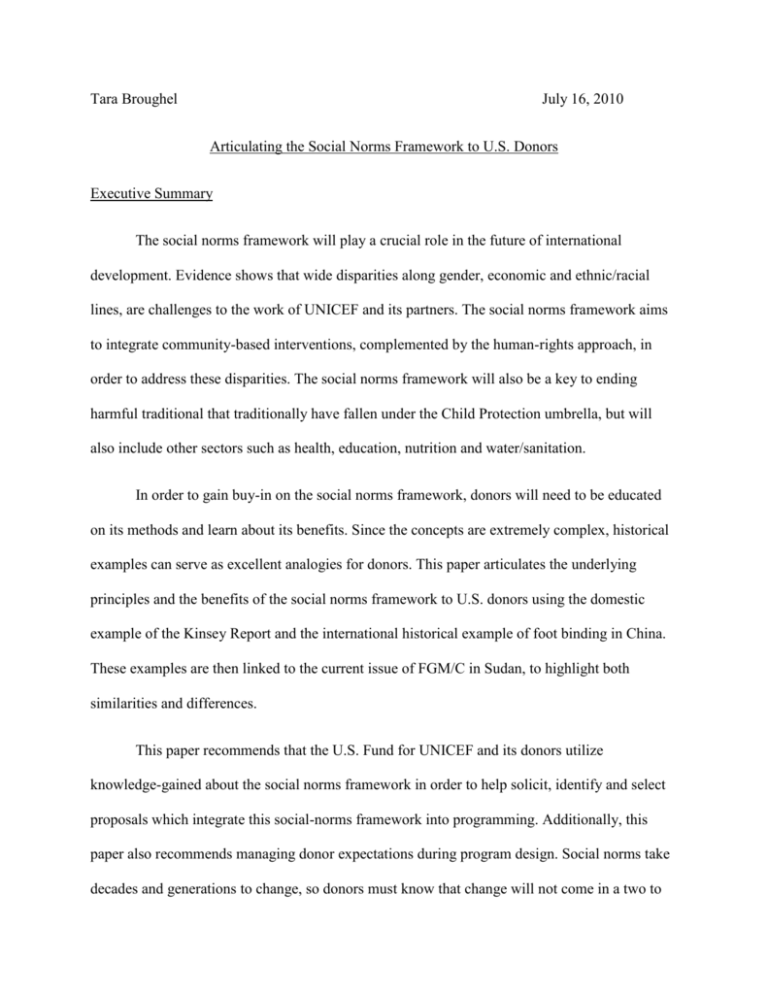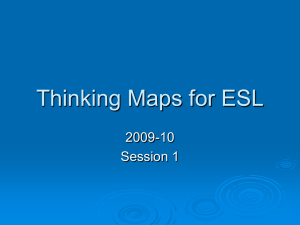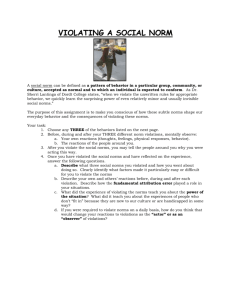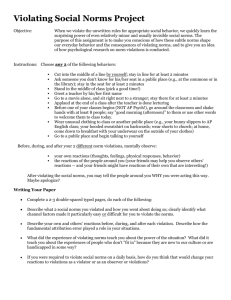
Tara Broughel
July 16, 2010
Articulating the Social Norms Framework to U.S. Donors
Executive Summary
The social norms framework will play a crucial role in the future of international
development. Evidence shows that wide disparities along gender, economic and ethnic/racial
lines, are challenges to the work of UNICEF and its partners. The social norms framework aims
to integrate community-based interventions, complemented by the human-rights approach, in
order to address these disparities. The social norms framework will also be a key to ending
harmful traditional that traditionally have fallen under the Child Protection umbrella, but will
also include other sectors such as health, education, nutrition and water/sanitation.
In order to gain buy-in on the social norms framework, donors will need to be educated
on its methods and learn about its benefits. Since the concepts are extremely complex, historical
examples can serve as excellent analogies for donors. This paper articulates the underlying
principles and the benefits of the social norms framework to U.S. donors using the domestic
example of the Kinsey Report and the international historical example of foot binding in China.
These examples are then linked to the current issue of FGM/C in Sudan, to highlight both
similarities and differences.
This paper recommends that the U.S. Fund for UNICEF and its donors utilize
knowledge-gained about the social norms framework in order to help solicit, identify and select
proposals which integrate this social-norms framework into programming. Additionally, this
paper also recommends managing donor expectations during program design. Social norms take
decades and generations to change, so donors must know that change will not come in a two to
three-year program. Monitoring and evaluation will be a key as well. Measurement of change
will be a challenge, and donors understand and expect that unorthodox methods of measurement,
utilizing qualitative data and a reliance on survey data, will likely play a larger role in reporting.
Introduction
The social norms analytical framework is relevant to a wide array of development issues,
from Child Protection issues such as Female Genital Mutilation/Cutting (FGM/C), child
marriage, child labor, violence against women, and the use of dowry, to other sectors, such as
health, vaccination, nutrition and water/sanitation/hygiene (WASH), and education. It is of the
utmost importance for UNICEF to utilize empirically tested programming approaches when
addressing any of these development issues. As a consequence it is extremely important for
National Committees to not only understand and identify proposals that incorporate the social
norms approach to programming but to be able to articulate these approaches to donors and also
communicate its programmatic advantages.
Furthermore, the social norms framework highlights that community-generated solutions
have the most potential to become entrenched and therefore sustainable. As UNICEF moves
towards a more holistic approach, further incorporating the underlying issues of exclusion and
deprivation (into the sector-based programming referenced above), the social norms framework
will be critical. In order to help tackle these disparities, the U.S. National Committee must
become an important ally and must educate its donor base on these cutting-edge program
innovations.
While the social norms approach utilizes disparate concepts such as game theory, social
dilemmas, psychology and network theory, in order to communicate these difficult concepts to
U.S.-based donors, the use of both domestic and international historical evidence can facilitate
donor understanding of the benefits of the social norms approach to programming. This case
study will examine how the release of the Kinsey Reports, in 1948 and 1953, helped spur drastic
social change in the U.S. with regard to sexual behavior and sexual beliefs. This paper will
complement the Kinsey example by highlighting how social norms/community
deliberation/community abandonment was essential to ending the practice of foot binding in
China in the early parts of the 20th Century. Finally, the paper will utilize the historical examples
to draw parallels to the current issue of FGM/C in Sudan.
Historical Evidence of Effective Social Norms-Based Intervention: Kinsey Report in United
States
The dramatic public opinions shift in the United States that started in the 1950s and
culminated in the “sexual revolution” of the 1960s and 1970s is an example of a change in a
social norm. This change found its roots in several causes: women’s economic empowerment
and educational empowerment serving as two of the leading reasons. However the release of the
Kinsey Reports served as a concrete catalyst for change and which likely accelerated these
changes. At the time of the Kinsey reports, socially conservative ideas about sex pervaded the
U.S – specifically with regard to women and the role of women in relationships. The public
followed social detailed scripts around how to behave with regard to sex. Sex in general was a
taboo topic; families and individuals learned not to discuss these subjects as a part of this script
and were explicitly banned from engaging in “deviant” sexual behavior (any sexual activity
outside of marriage or without procreation as a goal). In addition, reproductive health
specifically was hardly ever discussed, and as a result family planning services were, for the
most part, not available. Since pre-marital sex was also taboo, girls who became pregnant were
ostracized and isolated.
Punishment played a role in the pre-Kinsey social norms surrounding sex in the U.S.
Shame was the primary form of punishment, and much of the use of shame was rooted in
religious beliefs and the religious community. Pre-marital sex, extra-marital sex, masturbation
and family planning were all considered sins by most Protestant Christian/Catholic churches.
Families of pregnant teenagers felt shame. Myths about sex were rampant (e.g. masturbation
could cause one’s hand to fall off). In addition to informal shaming mechanisms, formal legal
sanction also existed. In many states, “sodomy” laws made certain types of sex considered to be
deviant (or not designed for procreation) illegal. Homosexual sex was also illegal in many states
and family planning and contraception had yet to be made a constitutional right.
It was with this backdrop that Alfred Kinsey released Sexual Behavior in the Human
Male (1948) and Sexual Behavior in the Human Female (1953). The reports featured surveybased interviews with 5300 men and 5940 women, who answered questions about how
frequently marital sex occurred, what types of marital sex occurred, whether or not extra or premarital sex occurred and whether or not individuals had had homosexual encounters. The survey
was anonymous, as the questions asked were considered to be extremely private (and even
taboo). The fact that these questions/topics were even posed came as a shock to the public at
large but the results were even more shocking. American couples were engaging in types of
sexual behavior at home that were considered to be immoral by the public’s standards. In
addition, significant percentages of Americans had engaged in extra or pre-marital sex or had
had homosexual encounters. The reports both were best sellers and clearly prompted Americans
to begin addressing these topics amongst their social circles and with their spouses.
While not an intentional “intervention” the release of the reports can be considered a
social norms intervention. The very act of making knowledge public, spurred the conservative
norms to decay, and accelerated the creation of new norms about sex. American attitudes about
sex, pre-marital relations, women’s sexuality and family planning all changed drastically within
in a matter of 20 years. Hundreds of years worth of entrenched social norms about sex
disappeared in less than a generation. Furthermore, the social changes spurred legal norms to
change as well. Within a matter of ten to fifteen years, the birth control pill was developed and
sanctioned by the Federal Drug Administration (FDA) in 1960 and the Supreme Court
recognized a woman’s constitutional right to access birth control in Griswold v. Connecticut
(1965). These developments seemingly might not have been possible had the Kinsey Reports not
been released. As legal barriers to sex fell, the social sanctions decayed even more. The
reasoning behind the end of social sanctions can be linked to many academic theories that serve
as the foundations to the social norms approach.
Social dilemmas exist when there is collective incentive to abandon a norm that might be
unpopular, but an individual cannot abandon the norm alone, since they believe that others in
society not only support that norm (empirical expectations), but that they expect all other
members of the community to follow that norm (normative expectations). In the case of the
Kinsey study, it is apparent in retrospect that Americans hoped to liberalize attitudes about sex
and reproductive health and also wanted to engage in more diverse types of sexual behaviors –
types of behaviors that typically carried social sanction. Furthermore, women clearly wanted to
take more control of their sex lives, and take more control of their bodies. Specifically with the
case of women, in retrospect, many clearly wanted more access to family planning and
reproductive education, but most believed that the rest of society did NOT want access to these
types of information and that individual women were expected NOT to discuss these subjects.
Women did not know that their peers might have held these views, because a social norm related
to silence existed around sex. This situation, pluralistic ignorance, resulted in a social dilemma in
which most women wanted the status quo to change, but individual women had no incentive to
spur the change out of fear of social reprisal or even legal sanction. The social dilemma is
diagrammed below in a simplified version of the dilemma, with two players. While both players
are both better off cooperating (holding more liberal views about sex and family planning
specifically) with one another to gain the 2nd best option (2), each player always has an incentive
to defect given the social sanctions and shame that apply, so both players continue to defect (fail
to discuss sex and reproductive health specifically, do not engage is more liberal sexual
behavior) and each receives the 2nd worst option (1).
Player 2
C
d
C
2,2
0,3
D
3,0
1,1
Player 1
The issuance of the Kinsey Report broke the silence around the issue that maintained
social dilemma, however this change was never intended. The norm change came about simply
because the public was able to access information. The norm of silence and the public’s lack of
information held the norm in place, when information was available, it was inevitable that the
norm would decay. The key to a social dilemma premised on pluralistic ignorance is an
unwillingness or an inability on the part of the community to discuss and deliberate the issues.
An individual cannot break the stalemate of a social dilemma, a community must do it. In the
Kinsey case, women did not know that other women felt the same way about them with regards
to sexual and reproductive health until the release of the Kinsey Report. At that time, community
discussion and deliberation occurred; both women and men realized that they were not alone in
doubting the social norm against discussing sex or sexual health. Once Americans realized that
others felt the same way, it was only a matter of time before the social conventions began to
deteriorate. The application of another social norm (supporting the discussion of sexual and
reproductive health) creates a different cost/benefit for individuals and groups. In Diagram 2,
social approval adds a value of 2 to both players cooperating and both players defecting and adds
a negative value of 2 when players are working in conjunction with one another. In this
scenario, it is no longer in the individual’s interest to defect, it is now in their interest to either
both cooperate or both defect. In real life, the public cooperated to dismiss the social norm
against gaining access to sexual health and achieved a hopeful equilibrium.
Player 2
c
d
C
4,4
0,1
D
1,0
3,3
Player 1
“Recategorization” also played a role in the shifting social norms about sex. Whereas
traditionally sex was considered dirty or immoral, the language around sex became more
positive. As the sexual revolution progressed, sex became beautiful and natural rather than dirty.
This shift, from pejorative to positive helped empower Americans to take charge of their own
sexual health and sexual behavior.
The Kinsey report served as the catalyst which spurred the public to abandon traditional
social norms surrounding sex. In this example, the simple ability to access information was
enough to spur the change previously well-entrenched social norms. The Kinsey report was not
the only cause of course, but it is hard to imagine that the norms would have eroded so quickly
without access to the information contained in the reports. The reports helped create a collective
mass, and then a tipping point of individuals, which caused the abandonment of the norm.
Historical Evidence of Effective Social Norms-Based Intervention: Foot binding in China
The Kinsey example illustrates how social norms were abandoned in a domestic, U.S.based historical example. Other international historical examples serve to further underscore how
social norms and social dilemmas play a role in the perpetuation of potentially harmful practices.
At the dawn of the 20th Century, the practice of foot binding had been widespread throughout
China for more than 1000 years. The practice was a prerequisite for young girls hoping to be
married. In groups where foot binding was the norm, close to 100 percent of women underwent
the procedure to bind the feet. Adherents of foot binding believed that foot bound women were
chaste and pure. This script of honor and virginity perpetuated the practice of foot binding,
despite its health implications. Furthermore, foot bound women were unable to walk long
distances, allowing for greater spousal control of their movements.
While foot binding had occurred in China for 1000 years, it ended in about one
generation. By the mid 20th Century, the practice had been entirely abandoned. How did this
occur? In China’s cities, “Natural Foot Societies” started to spring up. In these societies,
members vowed publicly not to bind the feet of their daughters and vowed that their sons would
not marry foot bound women. As the societies sprang up, it quickly behooved society members
to recruit more members to the societies and for new branches to form - the more people who
denounced the practice, the more possible mates for their children.
The Natural Foot societies were also aggressive in courting local Chinese leaders to help
give credibility to their cause. Confucian scholars helped the cause by declaring the practice as
“mutilation”, which was inconsistent with Confucian believes. In order to gain the trust of the
public and of individuals, it is crucial to garner the support of credible and respected local
leaders.
Social dilemmas and pluralistic ignorance, like in the Kinsey case, played a role in the
decay of foot binding. When the practice existed, since it was a prerequisite for marriage, all
women/girls underwent the procedure, even if individually they did not support the practice.
Foot binding was preferable to being unable to marry (and this the family genes died out) in
Chinese society. One individual could not abandon the practice without severe sanction: the
inability to marry. Pluralistic ignorance probably played a role as well - it is likely that many
(perhaps the majority) individuals did not support the practice, but they assumed that their fellow
citizens supported the practice, as evidenced by prevalence of foot bound women. The same
situation that dictated behavior in pre-Kinsey America dictated foot binding practices in China.
Even while the collective had reason to cooperate (to abandon the practice) each individual has
the incentive to defect (continue the practice). The situation is diagramed below.
Player 2
n
f
N
2,2
0,3
F
3,0
1,1
Player 1
(n= natural; f = footbind)
And as was the case with the Kinsey report’s release, the Natural Foot Societies applied a new
social norm to foot binding, as a critical mass and later a tipping point were breached. In this
second diagram, as a social norm to abandon forms, two points are added to both players
cooperating OR defecting, while two points are taken away when players do not act in tandem.
With the new social norms applied, the collective and the individual have incentive to abandon
foot binding.
Player 2
N
n
f
4,4
0,1
1,0
3,3
Player 1
F
With the spread of Natural Foot Societies, the binding norm disappeared within a
generation. As has been illustrated with the Kinsey and foot binding examples, the social norms
framework is an important lense through which social practices, be they harmful or helpful, can
be examined. The two case studies also shed light on modern day examples of harmful social
norms, and can help provide an analytical framework that might help to end these harmful
practices.
Current Applications for Social Norm Framework: FGM/C in Sudan
The Kinsey and foot binding examples illustrate historical examples of radical social
norm changes, and the lessons-learned from those case studies can help shed light on the current
issue of FGM/C in Sudan. FGM/C is closely tied to a script, which stresses honor, purity and
chastity for girls. The most recent statistics indicate that 89% of women undergo FGM/C in
Sudan, yet only 24% support the practice. As in the foot binding and Kinsey cases, this is an
example of pluralistic ignorance. A majority of the population would prefer to be rid of the
practice, but they continue to cut their daughters because of the social sanction (inability to
marry) associated with not circumcising their daughters. This also creates a social dilemma,
where the individual has an incentive to cut his/her daughter but if the group acted to collectively
abandon the practice, their collective well-being (and individual well-being) would improve. In
order to overcome this social dilemma, firstly, an alternative script must be created, which shows
that purity, chastity and honor can be attained in other ways. After the script changes,
community-based information campaigns and community-based alternatives must be created
stressing this new script. Trusted community members must be recruited to help spread the
message. Communities will then be able to “recategorize” the practice, using positive messaging
about uncut girls, to show communities that the social scripts they follow (with regard to girls
remaining pure, chaste, virginal) can be attained using alternative approaches. The current
“Saleema” campaign in Sudan is attempting to accomplish just that, however more grassroots,
bottom-up approaches must accompany it. It has been proven that individuals and communities
are more likely to trust an intervention if it follows other trust-building interventions. In the case
of FGM/C, perhaps education, health and WASH interventions should precede a FGM/C
intervention, as the community is more likely to trust the implementers after the initial
programming. Once these programs have taken root (in many communities they are already
ongoing) inter-marrying communities in Sudan in which pluralistic ignorance is occurring would
be ripe territory for social norms-based interventions to plant the seed of change with regard to
FGM/C. Community education, deliberation and then public denunciation could begin the
process in one village. That village can then take the message to its neighboring villages and so
on. Once a collective mass of communities denounced the practice and educated their fellow
communities (using “bridge” citizens), more and more intermarrying communities would be
incentivized to abandon the practice. There are stark similarities between the example of the
abandonment of foot binding in China and the current FGM/C situation in Sudan.
Social Norms Approach: Applications for National Committees and Donor Solicitation
The social norms approach is clearly relevant to the work of UNICEF, but also to its
national committees. In the 1990s, UNICEF, in part, focused its work on the human rights-based
approach. While the human rights-based approach is clearly a foundation for development work
(and is crucially relevant also to the social norms approach), it is insufficient. The human rightsbased approach is perceived to be western-centric. As a result of this, the human rights-based
approach needs a community-based complement – this will allow for legitimacy and
sustainability. Additionally, the social norms approach encourages translation of human rights
language into the local vernacular, so that human rights can hold meaning to a community.
Social norms can serve as this a community-based catalyst, but the social norms approach cannot
answer every problem, and is not useful for every situation, but it is a new lens with which
problems can be analyzed and solved.
Additionally, UNICEF is slowly attempting to shift towards a more and more holistic
approach. As the new Executive Director, Tony Lake, has indicated, more traditional sectorcentric programming must address traditional social or gender disparities. Addressing these
disparities is a key to development and child survival. As in the United States, improvements in
health, sanitation and education did not come from within a vacuum, those positive changes were
complemented by and accelerated by the empowerment of women and minorities
For the U.S National Committee, it is crucial to educate donors and supporters on the
social norms approach, as it has clear implications for program funding and proposal structuring.
Using historical analogies will likely be an effective way to articulate the components and
benefits of social-norms programming. As the Kinsey example shows, social norms change when
information is made available to the community. Additionally, many of the practices that might
be most effectively targeted for social norms-based interventions overlap with gender issues (e.g.
FGM/C, early marriage, dowry). Gender is a crucial territory for the future of international
development. Educated and independent women are not only more likely to produce educated
and thus more financially dependent children, but their children are more likely to survive and
educated women are more likely to access health services. There is clear donor support for
gender-focused programming, however the social norms approach tells us that the entire
community (men, boys, women, girls) must be active participants in gender-focused
programming.
Donors also must change their expectations. While many donors prefer to fund projects
with two to three-year timelines, programming that targets social norms will take much longer,
possibly five, ten or more years. There will also be clear opportunities for long-term monitoring
and evaluation studies for donors wishing to help create a larger base of empirically tested
studies about the impact of social norms based interventions in development work. Additionally,
qualitative analysis will likely become a more prevalent in evaluation of program
implementations. It will be important for National Committee staff to manage the expectations of
donors who might wish to fund empowerment programs or other social-norms based programs,
and measurement and evaluation for those programs will likely look very different from
traditional donor reports. How can reporting and evaluation measure changes in morals and
values? UNICEF must rely on aggressive surveying (with design utilizing social norms
frameworks), but this is expensive and time consuming. These survey and reports need to contain
credible and valid info, yet must be collected within UNICEF’s resource capacity. Reports might
contain more qualitative information as opposed to quantitative information. Donors must be
educated on these reporting challenges and on UNICEF’s efforts to address those challenges.
Conclusion
The social norms analytical framework is relevant to development work in two important ways:
1) By providing empirically and academically tested program tools that can help end
harmful traditional practices like child marriage, gender-based violence, FGM/C,
corporal punishment and many other.
2) The framework underscores the importance of holistic programming that targets the
underserved, excluded and disadvantaged in a given society with traditional sector-based
programs as well as social norms-grounded programming stressing empowerment,
human rights and citizenship building.
The U.S. Fund for UNICEF must take steps to educate donors about both of these key
elements. This paper addresses the first point, in part, by providing a U.S. based-analogy on the
impact of the Kinsey Study, to exhibit how social norms can change rapidly, with key
interventions. Both the Kinsey and foot binding examples illustrate how individuals can be
restricted by community-wide practices and social dilemmas, and provide examples about how
those social dilemmas ended as a result of the introduction of a social norms-based variable.
Those examples also provide an analogy with the current issue of FGM/C in Sudan. (It is
important to note though that not all social norms are based on social dilemmas). Additionally,
the U.S. Fund for UNICEF must target for funding proposals that address the holistic and social
norms-based approach described in the second bullet. To accomplish this, staff will need to be
trained on social norms and organization-wide buy-in will need to occur









